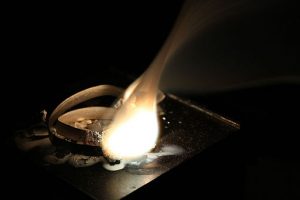Activity 3.8 NCERT Class 10 Science, Chapter 3 Metals and Non-metals
Brief procedure:
Activity 3.8 asks us to react oxides of metal and non-metals with water and check if it is acidic or basic in nature.
Observation:
We get metal oxide by burning the metal in the presence of oxygen. Metal oxide reacts with water to give a base. It turns the red litmus paper blue.
Similarly, the burning of non-metal produces its oxide. The solution of oxides of non-metal with water turns the blue litmus paper into the red.
Explanation:

Magnesium
Magnesium burns in air to form its oxide. See activity 1.1.
2Mg(s) + O2(g) ———–> 2MgO(s)
Magnesium oxide reacts with water and forms Magnesium Hydroxide.
MgO(S) + H2O(l) ———–> Mg(OH)2 (aq)
Magnesium hydroxide is a strong base. It makes the solution alkaline. So, the PH paper turns blue.
Application:
Many antacid syrups contain metal oxides like magnesium oxide and aluminium oxides. These metal oxides form respective metal hydroxide in the stomach and neutralises the acidity.
Sulphur:
Sulphur is a reactive non-metal; it burns to produce its oxide.
S(s) +O2(g) ————-> SO2(g)
Sulphur dioxide dissolves in water and forms sulphurous acid.
SO2(g) + H2O(l) ———–> H2SO3 (aq)
Sulphurous acid is a weak acid. Its 0.1N solution gives the PH of 1.5 which turns the blue litmus red.
Next: Burn test and flame colour of various metals, Activity 3.9.
See also: Comparison of properties of non-metals with metals, Activity 3.7.
Very Nice and Simple.
Easy to understand.
Radhe radhe
Thankk u so much!
Thank you
Thanku sir/maidem
Yes right
It is very good but if you write it in a proper format like
Aim :
Materials Required :
PROCEDURE :
Observation :
Inference / Conclusion :
Too good short explanations but need more!
this are the perfect observations they helped me alot